Hussian Z., AbdullahM.Z., AlimuddinZ. Basic Fluid Mechanics and Hydraulic Machines
Подождите немного. Документ загружается.

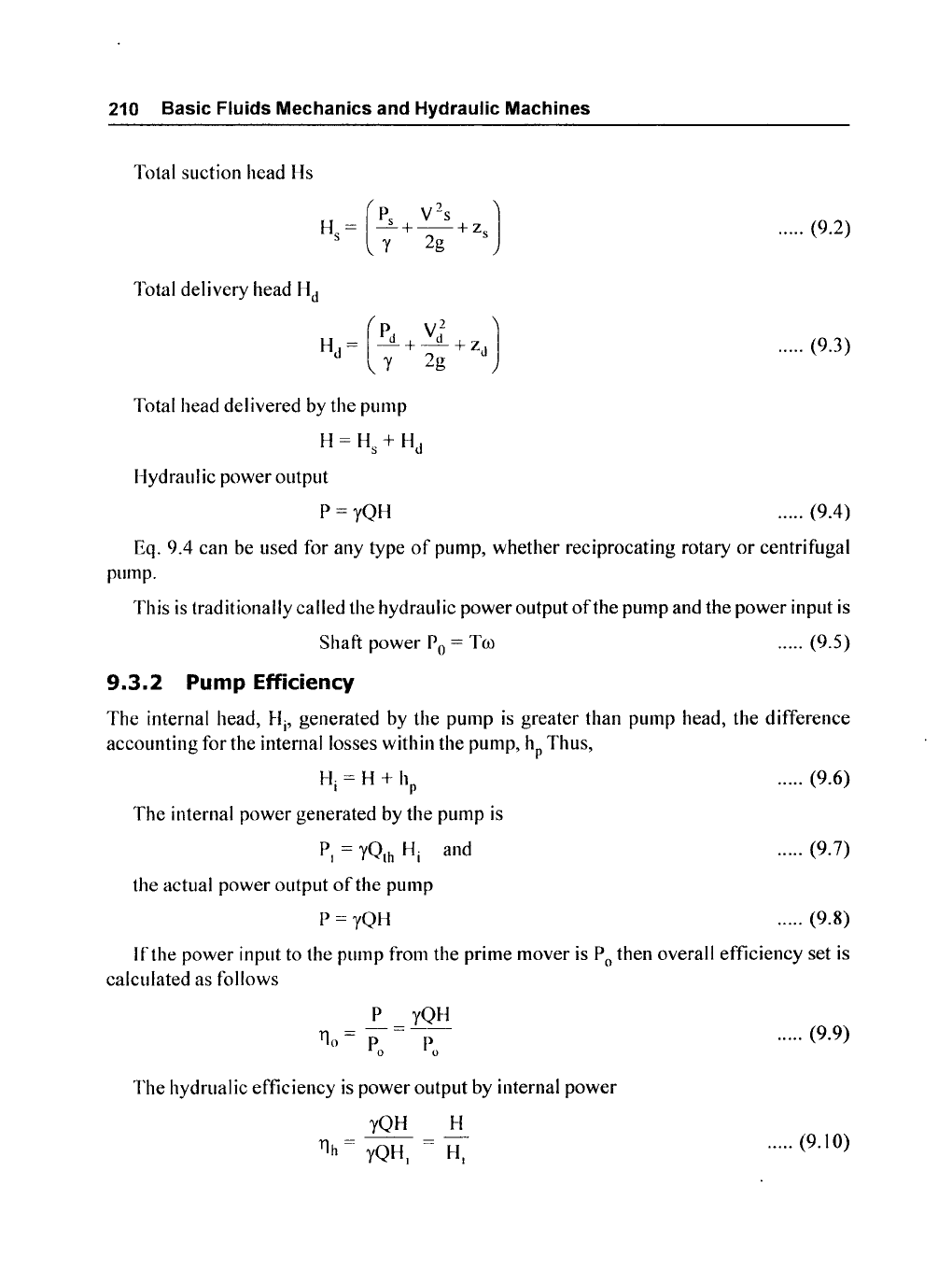
210 Basic Fluids Mechanics and Hydraulic Machines
Total suction head Hs
Total delivery head
Hd
H = ----.4.+_d
+zJ
(
p
y)
1
d r 2g
Total head delivered by the pump
H
=
Hs
+
Hd
Hydraulic power output
P =
rOH
..... (9.2)
..... (9.3)
..... (9.4)
Eq. 9.4 can be used for any type
of
pump, whether reciprocating rotary
or
centrifugal
pump.
This
is
traditionally called the hydraulic power output
of
the pump and the power input
is
Shaft power
Po
=
Tro
..... (9.5)
9.3.2
Pump Efficiency
The internal head, Hi' generated by the pump
is
greater than pump head, the difference
accounting for the internal losses within the pump,
hp
Thus,
Hi
= H +
hp
..... (9.6)
The internal power generated by the pump
is
PI
=
rOth
Hi
and
the actual power output
of
the pump
P
=
rOH
..... (9.7)
..... (9.8)
I f the power input to the pump from the prime mover is
Po
then overall efficiency set
is
calculated as follows
The hydrualic efficiency
is
power output by internal power
rO
H H
H,
..... (9.9)
..... (9.10)

Positive Displacement Pumps 211
Mechanical
efficiency
of
the
pump
is
P
j
yQu1Hj
11m
= p
==
TO)
o
..... (9.11)
The
volumetric efficiency is
Where
Q
L
hydraulic losses
due
to leakage
in
piston
clearances
1110
=
11h11m11v
..
.
..
(9.12)
The
overall
efficiency
is
the
product
of
three parts.
9.4
Application
of
Piston Pumps
The
pumps
are
extensively
used for
power
transfer
applications
in
the
off
shore,
power
transmissions, agriculture,
aerospace
and construction industries, to list
just
a few.
They
have also applications
in
chemical processing,
car
washing, as well as lood dairy and beverage
processing
.
Their
versatil ity and popularity
are
due fact their relat ively compact design, and
high viscosity performance.
Piston
pumps
are more efficient compared to
other
types
or
pumps. Volumetric efficiency
is around
90%
are
mechanical efficiency is also
90%
.
They
provide very high
power
density,
stiff, high
response
source
of
power, for
demanding
appl ications including servo systems.
Types
of
Pi.\,toll
Pumps
This
general type
of
pump
includes a
number
of
variations
some
of
which are described
below.
1.
Radial Piston
Pump
2.
Swashplate
Piston
Pump
3. Wobble Plate
Pump
4. Bent
Axis
Piston
Pump
5.
Gear
Pump
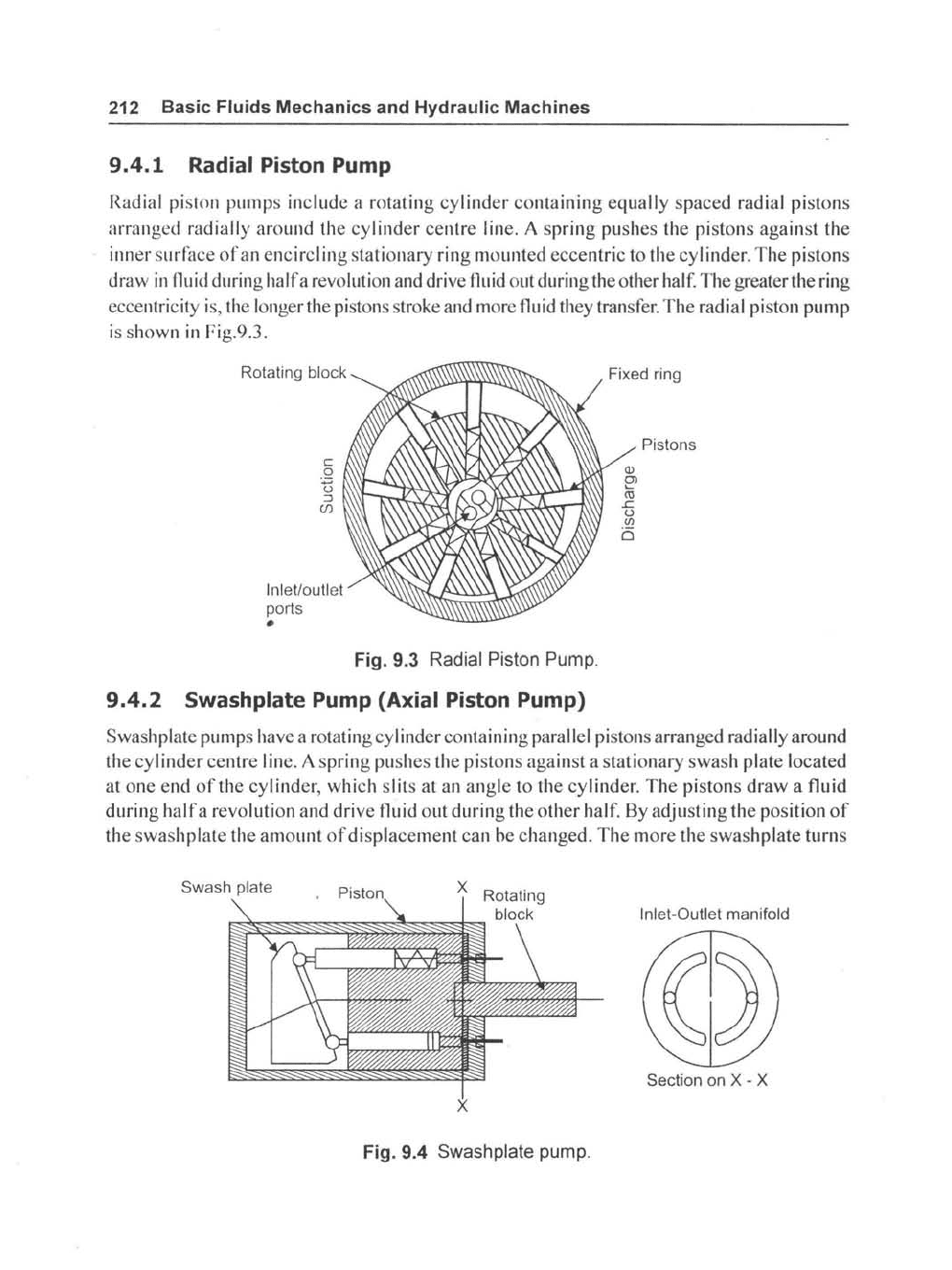
212 Basic Fluids Mechanics and Hydraulic Machines
9.4.1
Radial Piston Pump
Radial piston pumps include a rotating cylinder containing equally spaced radial pistons
arranged
radially around the cylinder centre line. A spring pushes the pistons against the
inner surface
of
an encircl ing stationary ring mounted eccentric to the cyl inder. The pistons
draw
in
fluid
during half a revolution
and
drive
fluid
out during
the
other
half.
The greater the ring
eccentricity
is,
the longer the pistons stroke and more fluid they transfer. The radial piston pump
is
shown
in
Pig.9.3.
Rotating block
c
.Q
t5
:J
(f)
Inlet/outlet
ports
•
Fig. 9.3 Radial Piston Pump.
9.4.2
Swash
plate
Pump (Axial Piston Pump)
(j)
e>
ro
.r::.
u
CfJ
o
Pistons
Swashplate pumps have a rotating cylinder containing parallel pistons arranged radially around
the cylinder centre line. A spring pushes the pistons against a stationary swash plate located
at one end
of
the cylinder, which slits at
an
angle to the cylinder. The pistons draw a fluid
during haifa revolution and drive fluid out during the other half.
By
adjusting the position
of
the swash plate the amount
of
displacement can
be
changed. The more the swashplate turns
Swash plate
. Pisto
X Rotating
block
Fig. 9.4 Swash plate pump.
Inlet-Outlet manifold
Section
on X - X
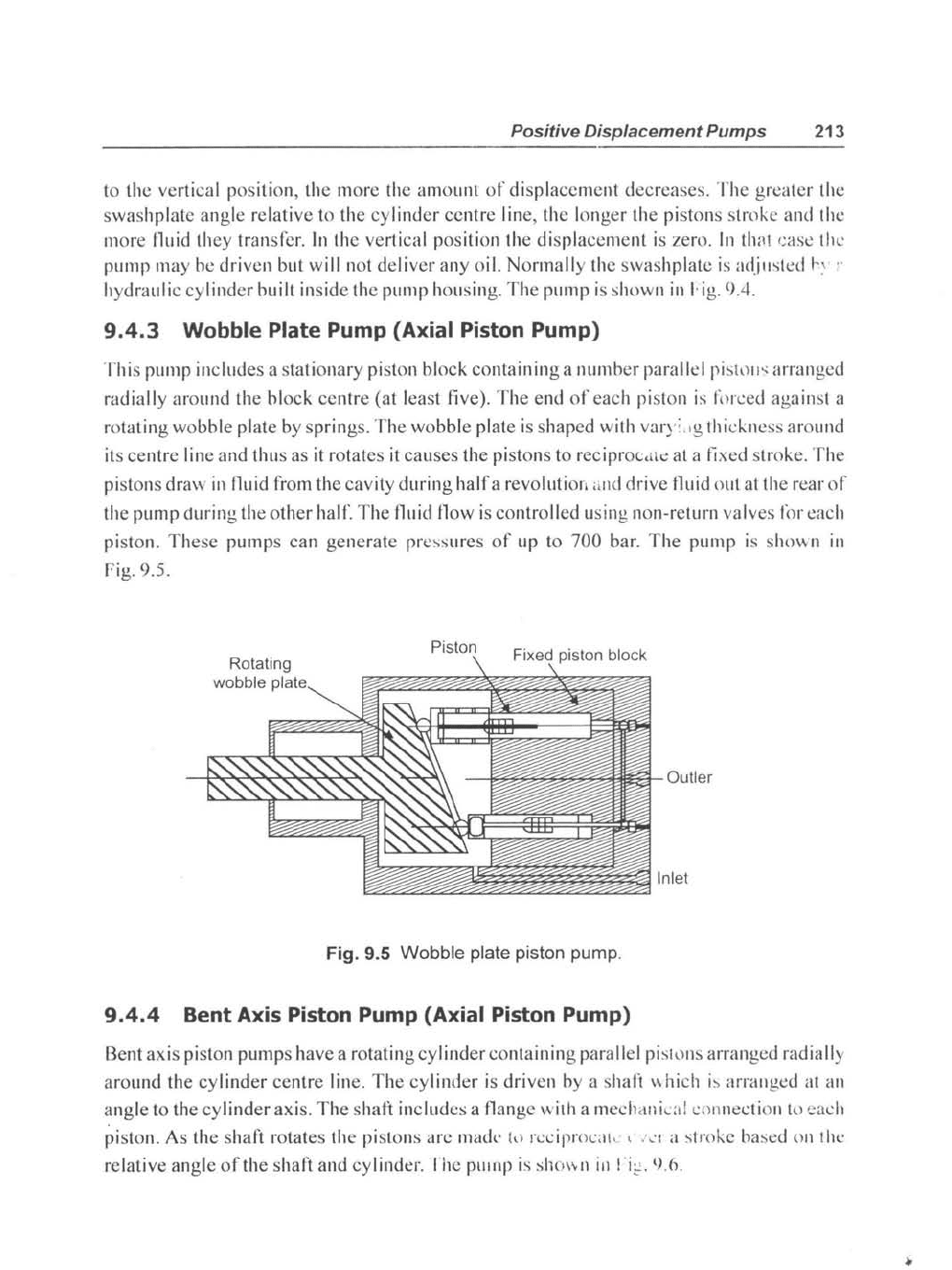
Positive Displacement Pumps 213
to the vertical position, the more the amount
of
displacement decreases. The greater the
swashplate angle relative to the cylinder centre line, the longer the pistons stroke and the
more fluid they transfer.
In
the vertical position the displacement
is
zero.
In
th
"t case
th
e
pump
may
be
driven but will not deliver any oil. Normally the swashplate
is
adjusted h\ ,
hydraulic cylinder built inside the pump housing. The pump
is
shown
in
hg
. 9.4.
9.4.3
Wobble Plate Pump (Axial Piston Pump)
This
pUIllP
includes a stationary piston block containing a number parallel
pistnll~
arranged
radially around the block centre (at least five). The end
of
each piston
is
forced against a
rotating wobble plate
by
springs. The wobble plate
is
shaped with
varY;
.l
g thickness around
its centre line and thus
as
it
rotates
it
causes the pistons to
recipro(;al~
at
a fixed stroke. The
pistons draw
in
fluid from the cavity during half a revolution
,illd
drive fluid out at the rear
of
the pump during the other half. The fluid flow
is
controlled using non-return valves for each
piston. These pumps can generate pressures
of
up
to 700 bar. The pump is shown
111
rig.
9.5.
Rotating
wobble
Piston
a;=dlllfIIllnlet
Fig. 9.5 Wobble plate piston pump.
9.4.4
Bent Axis Piston Pump (Axial Piston Pump)
Bent axis piston pumps have a rotating cylinder containing parallel
pistl)l1s
arranged radially
around the cylinder centre line. The cylinder
is
driven
by
a shah v,hich
is
arranged
at
an
ang
le
to the cylinder axis. The shaft includes a flange with a mechani
.:al
connection
to
each
piston. As the shaft rotates the pistons are
madt'
hi
rcciproc<l
k l /
':1
a stroke
ba
sed
on
the
relative angle
of
the shaft and cylinder. The plllnp
is
sl1
o\\n
in
I'i",.
1).6.
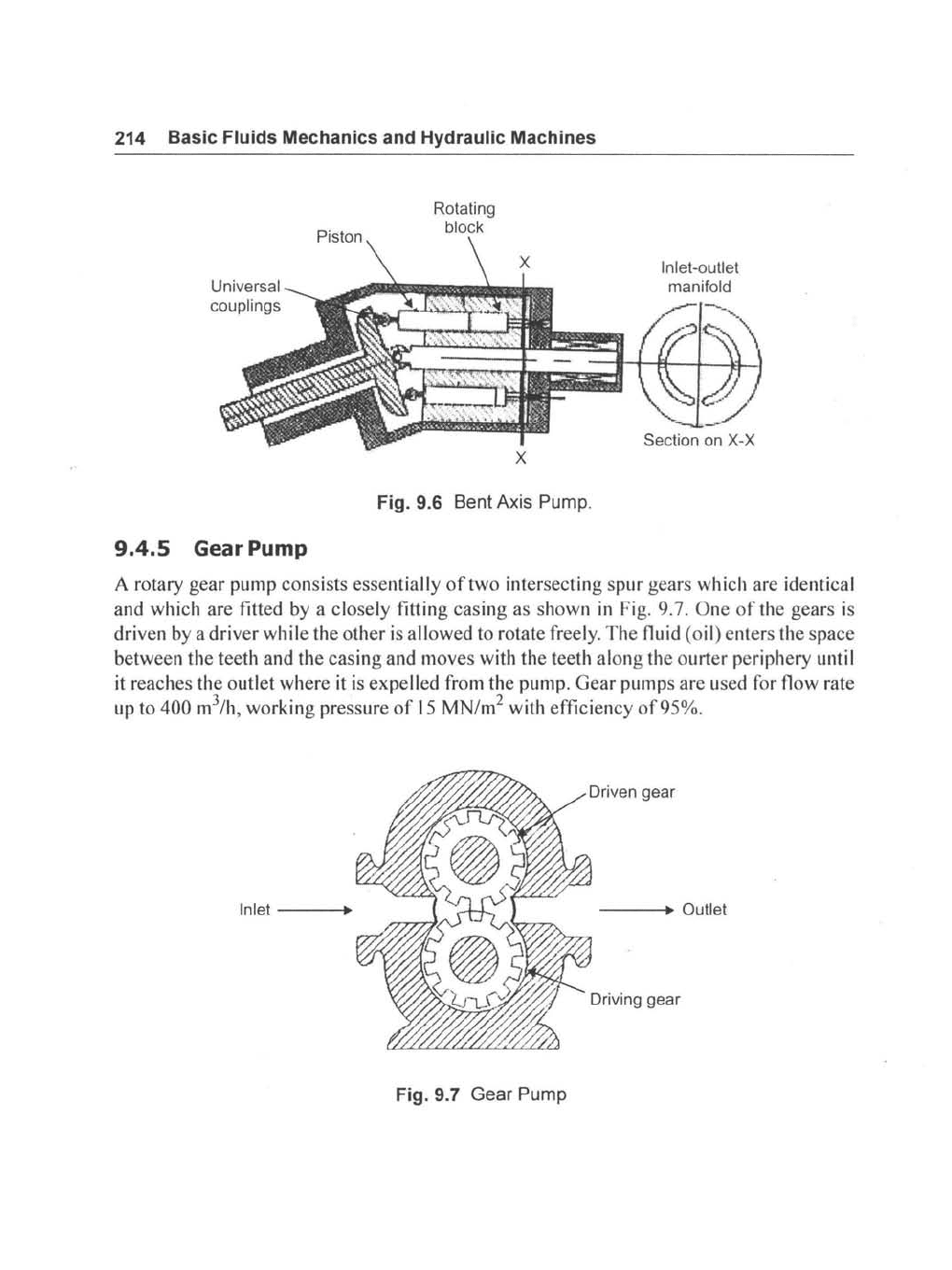
214 Basic Fluids Mechanics and Hydraulic Machines
Rotating
block
Fig. 9.6 Bent Axis Pump.
9.4.5
Gear Pump
A rotary gear pump consists essentially
of
two intersecting spur gears which are identical
and which are fitted
by
a closely fitting casing as shown
in
Fig. 9.7. One
of
the gears
is
driven by a driver while the other is allowed to rotate freely. The fluid (oil) enters the space
between the teeth and the casing and moves with the teeth along the ourter periphery until
it reaches the outlet where
it
is
expelled from the pump. Gear pumps are used for flow rate
up to
400 m
3
/h
, working pressure
of
15
MN/m2 with efficiency
of95%.
Driven gear
Inlet
---+~
---+~
Outlet
.'
Fig. 9.7 Gear Pump

Positive Displacement Pumps 215
Solved Examples
E.9.1 The reciprocating pump is used to increase the pressure 0.2 m
3
Is
of
water from
200 kPa to 600 kPa.
If
the overall efficiency
of
the pump
is
85% how much
electrical power
is
required to pump the
water?
The suction tank is
10
cm below
centre line
of
the pump and delivery tank
is
10
cm above the centre line
of
the
pump. Assume inlet and exit cross-sectional areas are equal, and velocities suction
and delivery neglected.
Solution
Total head across the pump
is
H = H + H =
-'?.
+ +
Z,
+
~
+ d +
Zd
(
p
*L
1 (P,2 1
s d Y g Y g
(
200
xl
0
3
1
(600
x
10
'
1
H = +
0.1
+ +
0.1
=
816m
9800 9800 .
Since the losses are neglected.
hydraulic power
=
yQH
= 9800 x 0.2 x 81.2 = 159 K W
hydraulic power
The
overall efficiency
110
= shaft power
159
:.
Shaft power = 0.85 = 187.2 kW
Electrical power
= 187.2 k W
E.9.2
The
gauge
is
installed at both suction and delivery. side.
The
water flows at the
rate
of
37.5 I/s the gauge at the suction indicated a vacuum pressure
of
54
kPa
and at the discharge section the gauge shows 160 kPa. Assume the suction and
discharge sections are at the same level with the diameter
of
15
cm and 12.5 cm,
respectively. Determine the total head
of
the pump.
Soilltion
Q
37.5x103
x 4
Velocity at the suction side -
= " =
2.1
mls
As
1txO.15-
Q
37.5x103
x4
Velocity at the discharge side
Ad
=
1t
X
o.
125
2
= 3.0 mls
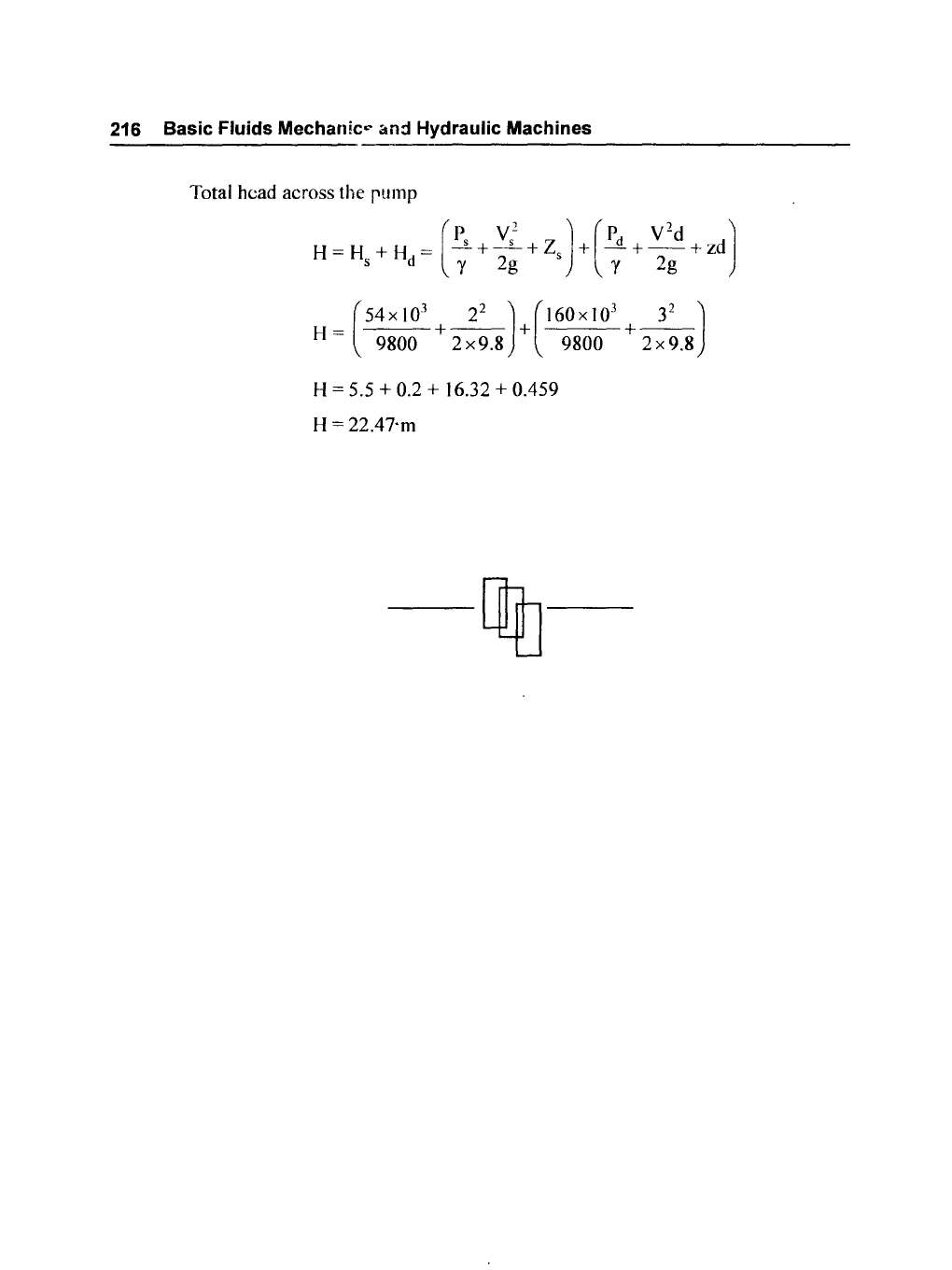
216 Basic Fluids Mechanic'" and Hydraulic Machines
---------------------------------------
Total head across the
rump
( P
s
Ys"
I r P
d
y
2
d )
H=
H + H =
l-+-+Zs)+
-+-+zd
S d Y 2g
"y
2g
(
54 x
I 0
3
2
2
) (
160 x I 0
3
3
2
)
H = 9800 +
2x9.8
+
9800
+
2x9.8
H = 5.5 + 0.2 + 16.32 + 0.459
H = 22.47-m

Multiple
Choice
Questions
-
---
- -
--
- -

"This page is Intentionally Left Blank"
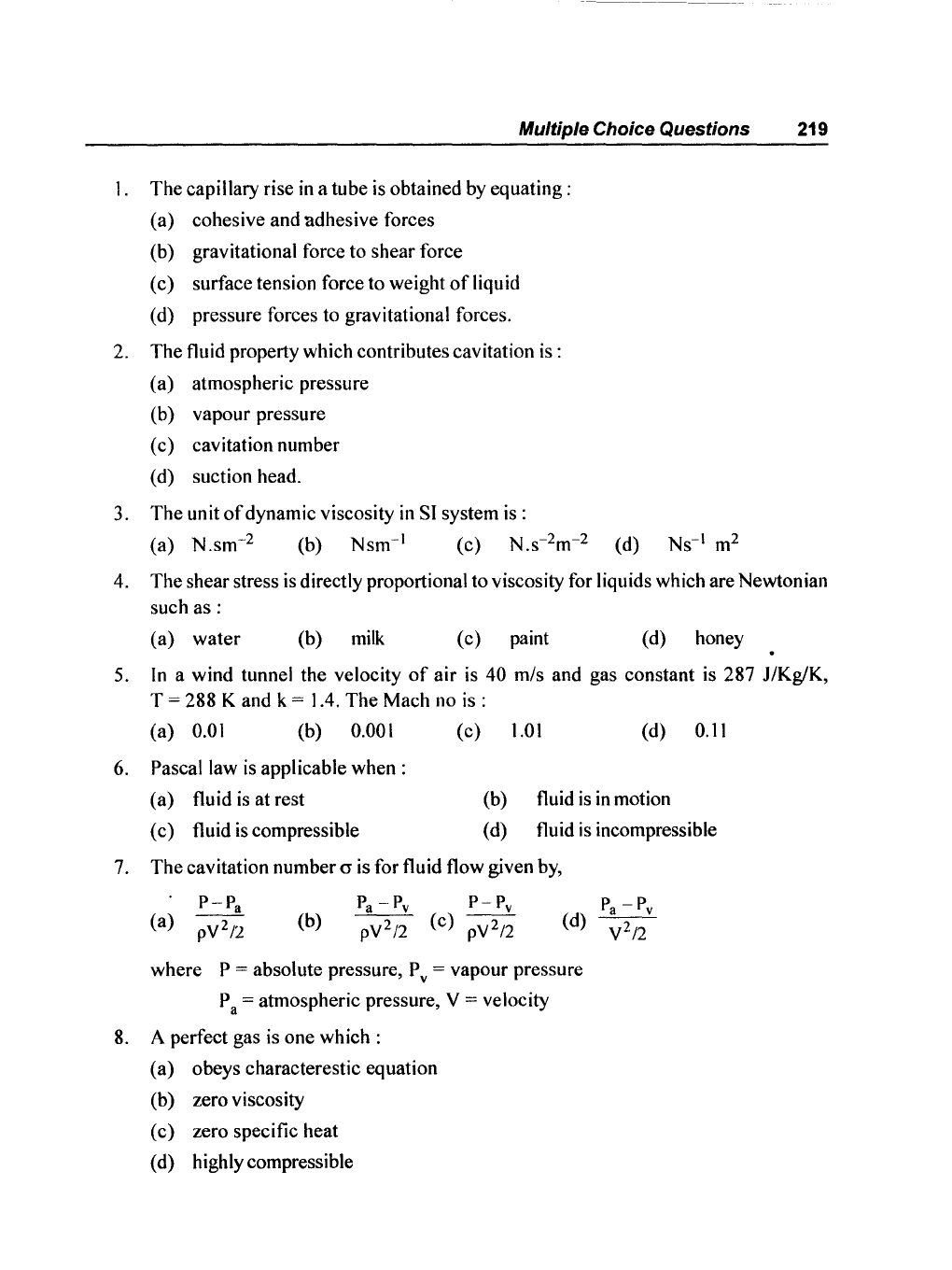
Multiple Choice Questions 219
1.
The
capillary rise
in
a tube is obtained by
equating:
(a) cohesive and adhesive forces
(b) gravitational force to shear force
(c) surface tension force to weight
of
liquid
(d) pressure forces to gravitational forces.
2. The fluid property which contributes cavitation is :
(a) atmospheric pressure
(b) vapour pressure
(c) cavitation number
(d) suction head.
3.
The
unit
of
dynamic viscosity
in
SI system
is
:
(a)
N.sm-
2
(b)
Nsm-
1
(c)
N.s-
2
m-
2
(d)
Ns-l
m
2
4. The shear stress
is
directly proportional to viscosity for liquids which are Newtonian
such
as:
(a)
water
(b) milk
(c) paint (d) honey
5.
In
a wind tunnel the velocity
of
air is 40
m/s
and gas constant is 287 J/Kg/K,
T
= 288 K and k = 1.4.
The
Mach no is :
(a)
0.01
(b) 0.001
(c)
1.01
(d)
0.11
6. Pascal law
is
applicable
when:
(a) fluid
is
at rest
(b) fluid
is
in
motion
(c) fluid
is
compressible
(d) fluid
is
incompressible
7.
The
cavitation number a is for fluid flow given by,
P-P
a
(a)
py212
(b)
P-P
v
(c)
py2/2
where P = absolute pressure, P v = vapour pressure
P a = atmospheric pressure, V = velocity
8. A perfect gas is one
which:
(a) obeys characterestic equation
(b) zero viscosity
(c) zero specific heat
(d) highly compressible
